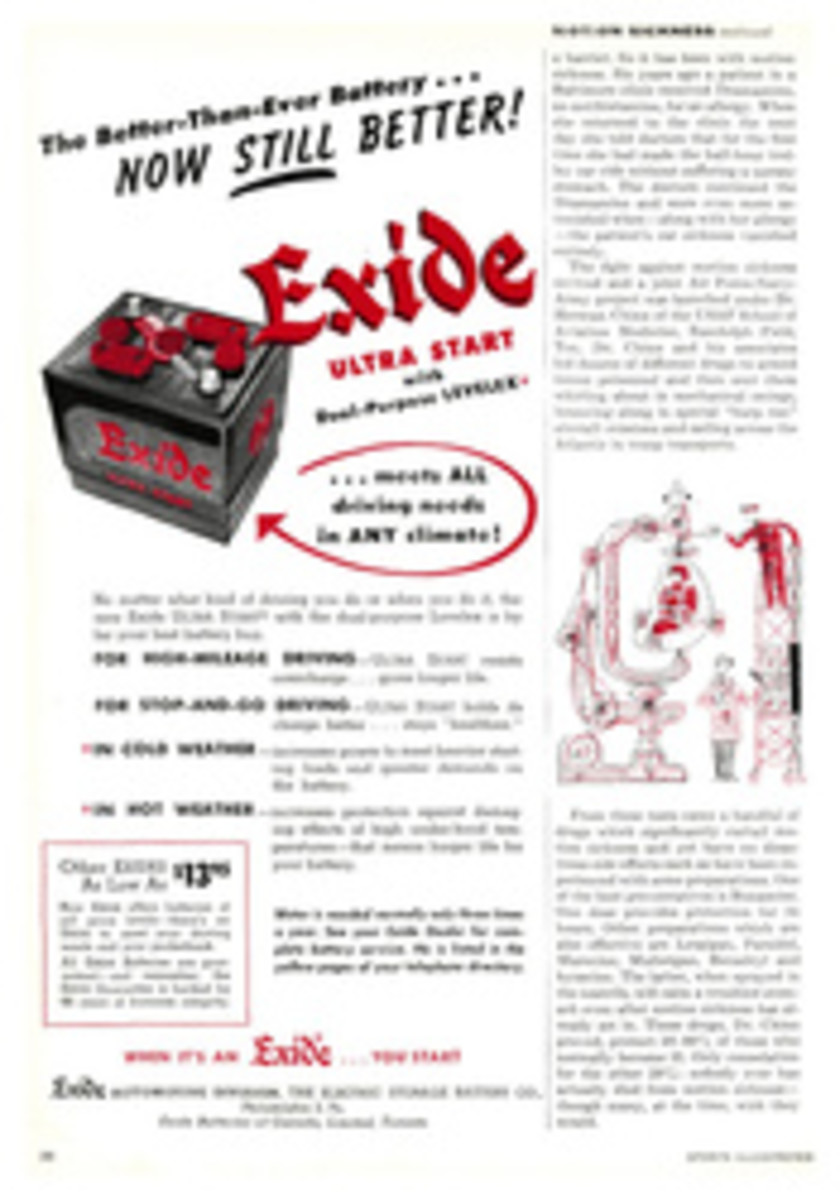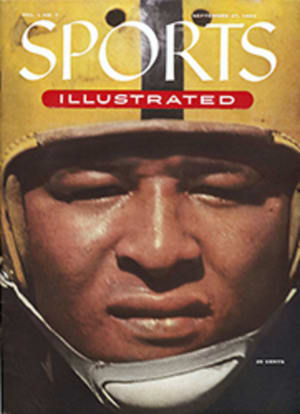
CLEVELAND PROUDLY PRESENTS:
THOSE INDIANS—Casey Stengel watched unhappily as the Cleveland Indians stumbled through a pre-game warm-up at the Yankee Stadium on an early September afternoon. The Indians were leading Stengel's Yankees, World's Champions for five successive years, by five and a half games and time was running out.
Suddenly Casey leaped to his feet and addressed the dugout audience of reporters, spreading his hands in frustration.
"How in hell," he shouted, "does Lopez do it with an infield like that?"
It was a good question, and not original with Stengel. Other managers and players, losing monotonously to the Indians, had been asking it for four months and finding no satisfactory answer.
At first base was Vic Wertz, a recently converted outfielder who hadn't been good enough for the hopeless Baltimore Orioles. At second was the stocky little Mexican, Roberto Avila, a solid hitter but only a fair fielder. At shortstop was Sam Dente, a 32-year-old castoff from the Red Sox, Browns, Senators and White Sox, whom the Indians had rescued from the minors. At third was Al Rosen, nursing a fractured index finger on his right hand and fighting a slump brought on by the injury.
Behind them were Bill Glynn, light-hitting first baseman who was employed as a defensive replacement for Wertz when the Indians were defending a slender lead in the late innings, which was nearly every day; Heine Majeski, a 37-year-old veteran who had been kicking around the major leagues since 1939; and George Strickland, the regular shortstop, who was wasting away under a mild diet necessitated by a double jaw fracture sustained in July.
"I guess," mused Stengel as he subsided to the bench, "with pitching like those fellas got, the infield don't get too many tough chances."
It was as nearly complete a one-sentence size-up of the Indians as has been made. Because they are blessed with pitching the like of which, for strength and depth, hasn't been seen since the rabbit first became an important ingredient of the official league ball, they have broken the Yankees' long reign as kings and now are aiming at an all-time American League record for victories.
The 1927 Yankees, commonly regarded as the mightiest ball club ever assembled, won 110 games, largely through brute power. Collectively they batted .307. Lou Gehrig hit .373, Babe Ruth and Earl Combs .356, Bob Meusel .337 and Tony Lazzeri .309. Ruth hit 60 home runs, Gehrig 47.
The Indians are challenging their record with one assured .300 hitter, Avila, and one other, Rosen, who went into the season's final week exactly at that level. Their siege guns, Rosen and Larry Doby, have hit about half as many homers as Ruth and Gehrig made in 1927.
But they have a fine defensive outfield, anchored by the brilliant Doby, the American League's answer to Willie Mays, and they have six pitchers (it may be seven when the last returns are in) with earned-run averages of less than 3.00. That is roughly equivalent, on the offensive side, to having six .330 hitters.
They have the 20-game winners, Bob Lemon and Early (Gus) Wynn, each of whom defeated the Yankees four times. They have Mike Garcia, still with a chance to reach 20 victories. They have the fabulous Bob Feller, no longer the schoolboy fireballer, but a skilled craftsman going strong at 35. And they have Art Houtteman, living up at last to his rich promise.
LEM OR GUS OR MIKE OR BOB OR ART
These are the five regular starters. To back them up is an amazingly effective bull-pen crew of two hard-throwing freshmen, Don Mossi and Ray Narleski, and one crafty old head, Hal Newhouser, coaxed from retirement last spring.
Estimates of the part played by pitching in a team's success vary from 30% to 75%. In the case of the Cleveland Indians it would be difficult to put too high a figure on it. Because they are not a heavy-hitting, high-scoring team and because they have defied the tradition that the common denominator of champions is a leakproof infield, the Indians have placed uncommon dependence upon their pitchers, and their pitchers haven't failed them.
The difference between the second-place Indians of 1951-52-53 and the pennant-winning Indians of '54 is largely in the bull pen, in a greatly improved Doby, in the consistent hitting of Avila, in the skillful catching of Jim Hegan—and in an exciting performance by the freshman left fielder, Al (Fuzzy) Smith, a lead-off man with an incredible capacity for reaching first by every means short of stealing it.
Directing the team with quiet patience is one whose every breathing moment is an eloquent denial of the legend of the explosive Latin temperament. In Alfonso Ramon Lopez the tensions and aggravations of an interminable succession of squeakers and cliff-hangers (the Indians play no other kind of games) express themselves in "nervous stomachs," never in tantrums.
In four years as manager of the Indians he has never raised his voice in anger, never chewed out a ballplayer within hearing range of teammates. No television actor, he doesn't dispute decisions with waving arms. On one play in a game with Washington, he contended that a wide throw had pulled Mickey Vernon, the Senators' first baseman, off the base. He was telling off the umpire quietly but effectively when Vernon interrupted.
"You're wrong, Al," he said. "I shifted my feet, but I had the bag."
"Sorry," said Lopez as he turned toward the dugout. "If Mickey says it, it's good enough for me."
As a tactician he will enter the World Series with one supreme advantage over his National League rival. Lopez will say, "Lem [or Gus or Mike or Bob or Art], you're pitchin' today. And Hal, you and Ray and Don are in the bull pen."
No other manager can make that statement.
[originallink:10456196:40742]
JARGON FOR BEGINNERS
Baseball has a jargon of its own invented by sportswriters seeking to avoid repetitive words and phrases when describing a game. Many of their inventions quite properly died the death clichés deserve, but many endured and today it is difficult to understand a broadcast or a newspaper account without some foreknowledge of baseball's glossary. Here is a brief list for beginners:
APPLE: Lump in player's throat brought on by tension; also a baseball.
BACKSTOP: Catcher; also screen behind home plate.
BATTERY: Pitcher and catcher together.
BEAN BALL: Pitch thrown at batter's head.
BLOOPER: Weak fly dropping safely just beyond infield.
BULL PEN: Area where relief pitchers warm up.
BUSHES: Minor leagues, especially low classification minors; also called sticks.
CHANGE-UP: Slow pitch thrown with motion of fast ball.
CHOKE: Grip bat several inches from bottom.
CHOKE-UP: Lose nerve.
CLUTCH: Moment of decision in game; also called pinch.
COUSIN: Player or team easy mark for another club.
CRIPPLE: Pitch thrown over plate with count of three balls, no strikes.
CYCLE: Single, double, triple, home run.
DUSTER: Pitch thrown close to batter's head to move him back from plate.
FULL COUNT: Three balls and two strikes.
GOPHER BALL: Pitch hit for home run; also gopher.
GRAND SLAM: Home run with bases full.
GROOVE: Center of strike zone.
HILL: Pitcher's mound.
HOT CORNER: Third base.
JOCKEY: Player who taunts opposition or umpires.
KEYSTONE: Second base.
KNUCKLE BALL: Erratically breaking pitch in which ball is gripped in knuckles.
LEAD-OFF: First batter in batting order.
PICK-OFF: Catch runner off base with sudden throw by pitcher or catcher.
PITCH-OUT: Pitch purposely thrown well out of strike zone to enable catcher to throw to a base.
RUBBER: Slab on pitcher's mound from which pitcher delivers ball.
SCREWBALL: Pitch which curves in flight but in opposite direction from curve ball.
SLIDER: Fast pitch which curves slightly but sharply. Cross between fast ball and curve.
SQUEEZE: Play in which batter tries to score runner from third base with bunt.

